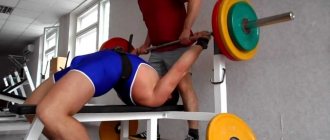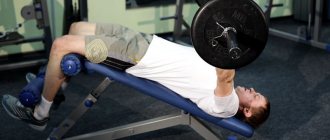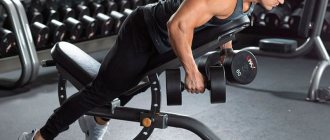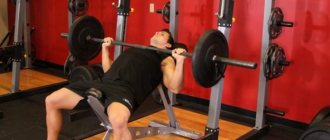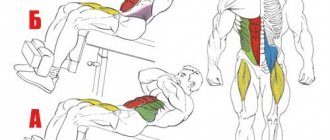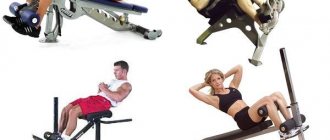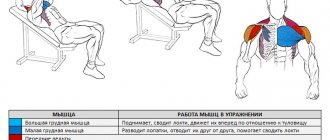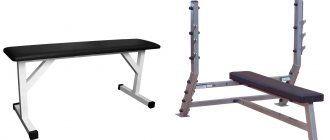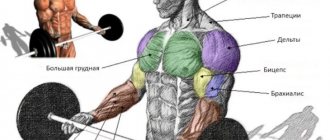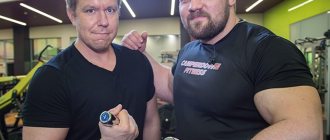What muscles work on the incline bench press?
The incline barbell bench press is considered one of the basic and key techniques for pumping and increasing the relief of the thoracic segment of the muscles. The most popular modifications are bench presses at an angle of 30 and 45 degrees, which distribute the load on the upper pectoral muscles. For beginners, it is better to perform the barbell press with an empty bar, without weight, under the supervision of a trainer. This will allow you to consolidate the correct parameters for performing the press.
• Main muscle group:
pectoral • Additional group: serratus anterior, rhomboid and lower trapezius, shoulder rotators, biceps, triceps, abdominal and buttock muscles, latissimus dorsi • Difficulty level: medium • Load type: Basic, multi-joint
Technique
Load distribution
•
The 30-degree barbell press primarily targets the mid-chest muscle group and some of the upper chest. • The bench's 45-degree inclination engages the upper area. • To pump up the lower group of chest muscles, the bent-over barbell bench press is performed in a modification with an upside-down incline.
Elbow position.
When spreading the elbows to the sides, the activity of the triceps decreases, and the work of the pectoral muscle group increases (which are pumped in the exercise). It is permissible in the lower maximum of the press to bring the elbows to the body and spread to the sides.
Hand placement options
• Narrow grip. To reduce the level of load on the thoracic segment and increase the work of the triceps muscle and anterior deltoids, grab the bar with a narrow grip. The range of movement with a narrow grip is maximum. • Wide stance. For maximum pumping of the upper and middle pectoral muscles, use a wide position of your hands on the bar. This modification will reduce the range of motion.
Equipment modifications
• Reverse grip press. • Smith Bench Angle Press Modification. • Using dumbbells. • Angle press in a power rack.
Practical nuances and aspects
To ensure that the bent-over bench press brings maximum results, use these tips:
• The emphasis is not on weight, but on technique. It is better to choose a lower working weight with which you will feel comfortable. • Press your heels or entire foot into the floor. This will increase your hold, stability and emphasis. • Points of contact between the body and the bench: head, both shoulders and shoulder blades, sacrum. • Maintain a natural arch in your back as you press and keep your shoulder blades retracted to minimize the risk of injury. • The higher the angle, the wider the grip. • Lower the bar firmly into the collarbone area, but do not place the barbell on your chest. In this case, a slight movement of the head back is quite acceptable. • Lower the barbell to the widow slower than you raise it. • At the bottom of the exercise, keep your forearms vertical. • Dampen inertia to prevent injury. • When you lie down on the bench, arch your spine and push your chest forward.
Bench press in the general training scheme
First, the main general muscle training is performed, and only after that they begin to load isolated segments of the pectoral muscle group. The incline press is done after basic training, for example, the classic press technique, dips.
Bent-over barbell row
I personally have a controversial opinion here. Many professionals claim that this manner of performing the exercise changes the emphasis of the impact. That is, when pulling to the chest, the upper back works more. I agree with this, but unfortunately the trapezius and rhomboid muscles will work more. Also, due to the lifting of the barbell up, the rear deltoids will be involved in the work. And in fact, we have only 20-30% inclusion of the latissimus muscles. For me, this is not a rational use of the energy resource of your body. And not everyone can perform such a movement. More precisely, everyone can do it, but for example, the same beginners will not get any results from it. And most importantly, you will have to reduce your working weight. All because of the position of the bar. Since the weight is shifted forward, it means it will pull us down more strongly. This will increase the load on your lower back. And working with a lot of weight will simply round it out. In this position, only injuries and severe pain await the lower back. Therefore, if you are a professional, you can try this option as a change. But I would not recommend it to beginners and people with average training.
Bent-over row with parallel grip
This is one of the alternatives to bent over rows. Only it is performed with a narrow handle from a block simulator. The exercise itself looks like the one shown in the picture below. That is, one edge of the bar rests against a counter or wall. And on the other we put on the pancakes themselves. Having set the weight we need, we take the handle and place the barbell on it. Our grip turns out to be parallel. And due to the fact that the handle itself is narrow, the range of movement will become incredibly large. In this way, you can achieve maximum contraction of all back muscles involved in the work. The exercise is simple, but at first it may seem unusual. Unfortunately, now most novice bodybuilders have replaced it with newfangled block trainers. But none of them compares in effectiveness to parallel grip barbell rows.
Smith machine row
Recently, it has become very fashionable to use the Smith machine to replace any basic movements. This did not bypass the bent over row of the barbell. I don’t see anything wrong with this and you can also achieve excellent results in Smith. But you will have to follow some rules to avoid injuries and get the desired back pump. Due to the fact that the barbell in the Smith machine only moves along a flat path, the shoulder jams. That is, you cannot move your shoulders forward and back. Therefore, in order not to injure them, it will be necessary to choose the optimal body position. Try moving closer to the bar or further away. When you feel that there is no discomfort in your shoulders, you can stop and work in this position. Also, don't lift too much weight. The simulator more specifically loads the muscles we need, so the weight in it will be less than with a regular barbell. And most importantly, do not round your lower back, as you can injure your spine. If you follow all these rules, then you can safely take this exercise and add it to your workouts.
T-bar row
This is sort of an improved version of the parallel grip barbell row. Only here a special frame is already used, which on one side is fixed on movable hinges (bolts), and on the other there is a protrusion on which the pancakes are mounted. The handle is also welded on, wide and narrow on newer models. There is also an option for lying T-bar rows. It is considered more isolated and excludes the lumbar region from working. Perfect for targeted back work and for people with spinal injuries, especially in the lower region. In terms of execution, the T-bar is considered more convenient and does not require much preparation. The amplitude of movement will depend on the width of the grip. That is, a narrow position of the arms stretches the back muscles more, and a wide one stretches them a little less. It’s better, of course, to vary the approaches by changing the grip width. This will give your back a varied load. Thus, it will work out as much as possible, which will lead to an increase in muscle mass and give them definition. So if you don’t want to do bent-over rows with a regular barbell, feel free to switch to a T-bar. It’s better to try and look for the most suitable option for yourself.
Execution Sequence
1. Set the degree of inclination of the bench depending on which muscle segment you want to pump. 2. Install the barbell and equip it with working weight. Remember to use clamps on both ends of the projectile. If you are a beginner, perform bench presses with an empty bar. 3. Starting position: lying on a bench, hold the bar with an overhand grip above the body. 4. Only your palms should support the barbell, and place your thumb on top of it. 5. While inhaling, smoothly and at a slow pace lower the bar so that it touches the upper segment of the chest. 6. Straining your muscles, fix the position for 1-2 seconds. 7. While exhaling, use the muscles of the upper chest segment to squeeze the barbell and return to the starting position. 8. Don't throw the projectile onto your chest, but don't push it up uncontrollably either. Maintain a smooth, moderate pace throughout the exercise. 9. Repeat the barbell press at 45 degrees the desired number of times.
Advantages of the Dumbbell Press
Extended trajectory
When working with dumbbells, your arms work with greater amplitude. The reason for this is the fact that at the top of your trajectory your arms are much closer together than when training with a barbell. In addition, when lowering, the elbow joints move further - nothing interferes with them. In other words, the absence of a bar removes all restrictions imposed by it. The load increases, thereby working the muscles more, which has a positive effect on the effectiveness of this basic exercise.
More muscles are used
When lifting dumbbells, each athlete must use more muscles to maintain balance. In the case of a barbell, the arms are in a fixed position, but with dumbbells you need to control the course of their movement, since they are not secured to each other in any way. Therefore, you have to use more stabilizer muscles in order to perform the exercise correctly.
Peak contraction is more effective
More precisely, you have the opportunity to better load the muscles at the very top of the dumbbell movement. This is due to the fact that when lifting the apparatus in the upper position, you begin to contract them - it is when performing this part of the exercise (as well as during lying dumbbell flyes) that it is possible to more effectively contract the pectoral muscles. The bar practically does not allow you to do this, since you are completely deprived of the ability to change the position of your hands in the horizontal plane.
Improved stretch
We are talking about the lowest point of the trajectory. The barbell press will never be an effective exercise for stretching the chest muscles, no matter how much you want it to be. There are two main reasons for this. The first is the bar, which at a certain moment will lie on your chest and will not allow you to move your arms further down. The second is a decrease in shoulder mobility. Try the following exercise: take any stick, lie down on a bench and perform all the same movements that you do during a bench press. You will notice that in order to touch the stick to your chest, you will have to make some effort. Why? The shoulder joints are not allowed. Many athletes often place the bar on their chest. And they do this not because the mobility of their shoulder joints is highly developed, but in order to stretch the muscles at the lowest point. When working with dumbbells, this problem does not exist - the free position of the arms allows you to lower them far down, which has a beneficial effect on stretching.
No insurance required
While working with dumbbells, there is no need for a belay partner to be with you at all times. If you feel like you can't do any more reps, you can easily drop the dumbbells by spreading your arms out to the sides. But this won’t work with a barbell, and it could fall right on you, causing serious injury.
Best option for beginners
For beginners in the gym, going under the barbell right away is not safe. The standard bar weighs 20 kilograms, which for some may be a lot of weight at first. Therefore, at the initial stage it is better to work with light weights (dumbbells) in order to develop the correct technique. And only then “connect” the barbell.
Lack of attachment to one place
To work with a barbell you need stands, and this significantly reduces mobility. In addition, to perform the exercise safely, you need a safety net. With dumbbells, neither the first nor the second is necessary. To use dumbbells, you only need a bench that can be installed either horizontally or at an angle. At home, a row of stools can be used as a bench. Want to lift multiple weights? Just place them at your fingertips. When you're done with one weight, you can easily move on to another. And in order to change the weight on the bar, you have to get up, remove some weights, and hang others.
Basic mistakes
• Incorrect bench angle. An inclination angle of more than 60 degrees will shift the emphasis to the deltas. • Lifting of the pelvis and head from the bench, excessive arching of the back in the lumbar and thoracic regions. This position places the load on the shoulders rather than the chest. • The point of descent of the barbell is slightly higher than during a bench press. Throwing a projectile onto the collarbone can result in bone injuries. The correct point is found experimentally: at the lowest point you need to hold your forearms perpendicular to the floor surface. • Squeezing the barbell until your arms are straight. When the arms are fully straightened, the load is redistributed not to the pectoral muscles, but to the triceps brachii. Therefore, it is important to keep your elbows slightly bent. • The projectile should be lowered and squeezed out at an angle. Vertical movement places extra stress on the shoulder muscles, which increases the risk of injury. • When working with heavy weights, it is recommended to have a spotter. • Number of repetitions: 3 sets of 10-12 repetitions • Weight: The working weight is selected so as to repeat the bench press 10-12 times
Number of repetitions
: 3 sets of 10-12 repetitions
Weight
: The working weight is selected so as to repeat the bench press 10-12 times
Incline bench press how to do it correctly
What should the slope be? The tilt angle should be about 30° to the horizontal. You must drive this axiom firmly into your head. The higher the inclination, the more useless the exercise is due to the large shift in load on the deltoids.
The most optimal inclination of the bench
This tilt removes significant load from the bottom of the chest and transfers it to the entire surface of the pectoral muscle (and not specifically to the top, as many people think). This way the upper pectorals receive the necessary stimulation. We can say that with this tilt the whole chest works.
A positive inclination also significantly relieves stress on the triceps. For this reason, you will be able to take the barbell a little narrower than in the classic bench press and work in a larger amplitude.
The grip width for the incline press should be slightly wider than shoulder width. This is exactly the golden mean that maintains good amplitude and does not involve the triceps in the work (but do not think that they will not be loaded at all). This grip corresponds to your hand placement in push-ups from the floor. In them you must place your hands in such a way as to develop maximum strength. Optimally - slightly wider than shoulder width. Remember your push-up grip and use it on the incline press.
The grip width in the incline press is slightly narrower than in the classic one.
At the top point, you should not straighten your arms completely blocking your elbows. Thus, you will give all the load to the triceps. Working within the amplitude, you maintain chest tension throughout the entire approach. At the lowest point, you only need to lightly touch your chest (you don’t have to touch it at all) and immediately start lifting. It is unacceptable to put the barbell on your chest or do it in a “beat” - the load will go away, which is not what we need.
One of the most interesting points is the position of the legs. The fact is that the bodybuilding bench press and the lifting press are radically different. The bodybuilder's task is to load the target muscles using a large weight in a large number of repetitions, while the lifter's task is to push the maximum maximum weight in a single repetition, using the entire body.
The lifter needs the legs as one of the support points for the bridge, which makes it easier to perform the press. The bodybuilder does not “bridge”, his lower back is pressed against the bench, and the load is distributed to the necessary muscles.
For greater isolation of the pectoral muscles in the incline press, you should remove the space between the lower back and the bench. Accordingly, the load will leave the bottom and transfer to the entire surface of the chest. This can be achieved by raising your legs up (you can put them on a bench).
As for breathing, you should exhale forcefully. Inhale as you lower the barbell, while stretching your chest as much as possible. From the bottom point, push not only the weight, but also the air.
Remember that the closer your elbows are to your body, the more your triceps are involved. The farther your elbows are spread to the sides, the more your chest works.
As for the number of repetitions, in bodybuilding it is 6-12 repetitions. To practice the technique, use a larger number (15-30) and a small weight of weights. Having mastered the technique, you will be able to progress faster and better in the future than if you had not spent 1-2 months learning the exercise.
Holding the barbell, squeeze your shoulder blades together, lower your shoulders and push your chest forward. Lower the barbell slowly and raise it quickly but smoothly.
Bench press at an angle video exercise
Brief conclusions
The incline barbell press is considered basic for improving the muscles of the upper segment of the body, forming a wide and powerful chest. Anatomically, the technique resembles push-ups, but the use of a barbell allows you to use additional weight.
Correct execution of the incline bench press technique requires that the feet are pressed to the floor, the shoulder blades are retracted, and a minimum deflection is maintained in the back. The pelvis is pressed against the support bench. The barbell must be lowered diagonally, and at the lowest point of the amplitude, do not lower it all the way to the collarbones.
Author: ForceMan from 04/06/2018, 07:00
- 0
Summing up
In conclusion, it should be noted that each exercise must be performed correctly, and for this the training program must be thought out and worked out. Carefully verified actions are the key to the successful development of your own body and maintaining your health intact. There is no need to overestimate your strengths and capabilities in order to show off in front of others in the gym, because you cannot be stronger than everyone else, there will always be someone stronger.
The only one who should be surprised by an athlete is himself, every time overcoming pain and fatigue on the path to success. And this is very difficult without carefully thought out and worked out actions, as well as the strictest self-control.
Therefore, instead of spending a long time on the Internet in search of unique effective programs, testing the found material on yourself and gaining knowledge through your own trial and error, it is better to turn to a professional trainer and work under his guidance.
